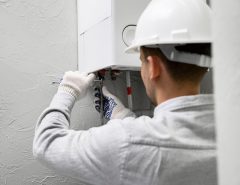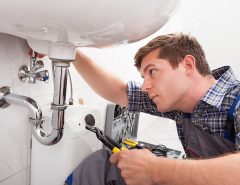Hey there, DIY heroes! So, picture this: you’re chilling at home, watching your favorite show, when suddenly you hear that dreaded hissing sound. Yep, you guessed it – a leaky pipe has decided to steal the spotlight. But fear not! I’m here to be your virtual sidekick in the battle against leaks. Let’s dive into some quick fixes that’ll have you feeling like a plumbing pro in no time.
1. The Old Trusty Bucket Trick:
You know what they say, sometimes the simplest solutions are the most effective. If you’ve got a leak, grab a bucket, place it strategically under the drip, and voila – you’ve just prevented a mini indoor flood. It’s like playing catch with your plumbing.
2. The Rubber Band Aid – AKA Hose Clamps:
Now, I’m not talking about the band-aids you slap on your finger when you’ve had a disagreement with a kitchen knife. I’m talking about hose clamps. These bad boys can temporarily seal up a leaky pipe faster than you can say “plumber.” Just tighten ’em around the leak, and you’ve got yourself a quick fix that even MacGyver would be proud of.
3. The Magical World of Epoxy Putty:
Epoxy putty is like the superhero of DIY plumbing. It’s moldable, it’s sturdy, and it can patch up a leak like it’s no big deal. Get your hands on some, knead it like you’re preparing some high-stakes dough, and then apply it to the leak. It hardens into a water-resistant seal – problem solved!
4. Teflon Tape – The Unsung Hero:
Teflon tape might seem like it’s just hanging out in your toolbox, waiting for its moment to shine. Well, folks, this is its moment. Wrap a bit of Teflon tape around the leaking joint, and watch as it works its magic, creating a seal that says, “Leak? What leak?”
5. The Power of Pipe Clamps:
Think of pipe clamps as the Hulk of the plumbing world – strong, reliable, and ready to smash that leak into oblivion. Slap a couple of these babies on either side of the leak, tighten them up, and watch as they bring peace back to your pipes.
6. Plumbing Tape – Because It’s Not Just for Plumbers:
Forget what you heard – plumbing tape isn’t exclusive to the pros. If you’ve got a minor leak, wrap some plumbing tape around the affected area, and witness the transformation. It’s like giving your pipes a cozy little scarf to keep them warm and leak-free.
7. Embrace the Power of a Pipe Sleeve:
Pipe sleeves are like the superhero capes of the plumbing world. Slip one over the leak, secure it in place, and let it work its magic. It’s a bit like giving your pipes a stylish makeover while simultaneously fixing the issue. Double win!
8. The Classic Pipe Clamp and Rubber:
This dynamic duo is a force to be reckoned with. Place a rubber pad over the leak, clamp it down with a pipe clamp, and watch as they join forces to put an end to that pesky dripping. Teamwork makes the dream work, right?
9. The “Turn It Off, Then On Again” Move–For Pipes:
Sometimes, the most effective fixes are the ones we overlook. Turn off your water supply, wait a bit, and then turn it back on. It’s like giving your pipes a little break to recalibrate. You’d be surprised how often this simple move can work wonders.
10. The Emergency Pipe Repair Tape:
Emergency situations call for emergency solutions. Enter pipe repair tape – a self-fusing silicone tape that can patch up leaks in a pinch. It’s like the duct tape of the plumbing world but specifically designed for these situations. Just wrap it around the leak, and let it do its thing.
Alright, my fellow DIY warriors, armed with these quick fixes, you’re ready to take on any leak that comes your way. Remember, the key is to act fast – don’t let that drip turn into a deluge. Now go forth, fix those leaks, and revel in the glory of a dry, leak-free home!
FAQs:
Q1: Can I use duct tape to fix a pipe leak?
A: While duct tape is a handy tool, it’s not the best solution for pipe leaks. Opt for specialized plumbing tape or other quick fixes like epoxy putty for a more effective and long-lasting repair.
Q2: How long do these DIY fixes last?
A: The longevity of DIY fixes depends on the severity of the leak and the method used. Some quick fixes are temporary solutions, and it’s advisable to consult a professional plumber for a more permanent repair.
Q3: Is it necessary to turn off the water supply before attempting these fixes?
A: Yes, it’s crucial to turn off the water supply before attempting any DIY fixes. This prevents further damage and ensures a safer working environment.
Q4: Can I use these methods for all types of pipes?
A: The effectiveness of these methods may vary based on the type of pipe and the severity of the leak. It’s recommended to match the repair method with the specific characteristics of the pipe and consult a professional if needed.
Q5: When should I call a professional plumber?
A: If the leak persists despite your DIY efforts, if the damage is extensive, or if you’re unsure about the best course of action, it’s time to call in the professionals. They have the expertise to assess and address plumbing issues effectively.




